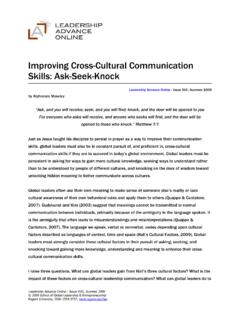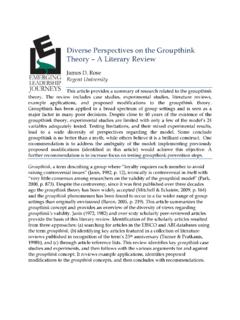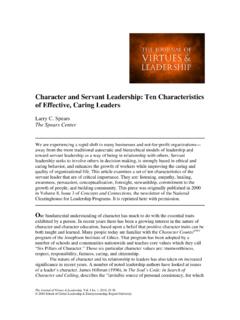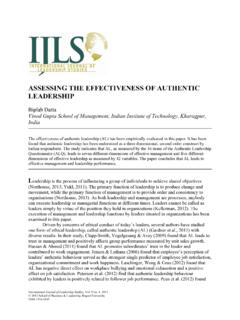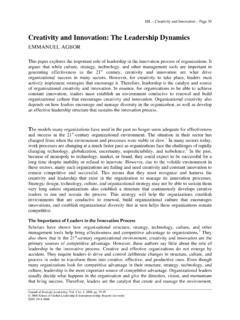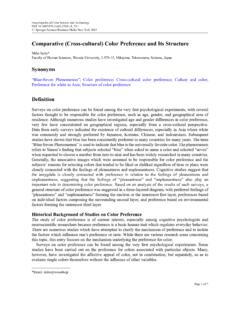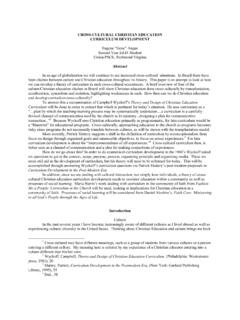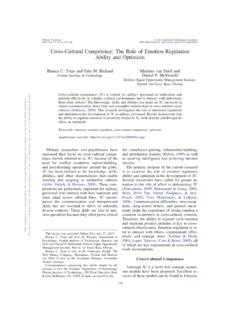Transcription of LEADERSHIP ACROSS DIFFERENT CULTURES - …
1 LEADERSHIP ACROSS DIFFERENT CULTURES The ear of the leader must ring with the voices of the people. Woodrow Wilson With the march of globalization and internationalization growing louder and stronger, few suc-cessful businesses can now escape the need to work ACROSS CULTURES . Today s leaders need to be adept at leading and managing people of DIFFERENT CULTURES ; they need to listen to the voices of the people as well as understand what those voices may actually be telling them. This in essence is the crux of the challenge; when people perceive the world, communicate and view their leaders in DIFFERENT ways, the leader s ears may be ringing with misunderstood messages.
2 The leader will come ACROSS cultural issues in many DIFFERENT guises. By way of illustrating the challenges of cross - cultural LEADERSHIP and for the sake of brevity this article will examine two interdependent issues: the role of a leader and communication. Source: INTERCULTURAL MANAGEMENT: LEADERSHIP AMONG DIFFERENT COUNTRIES The art of communication is the language of LEADERSHIP James Humes Today's businesses are complex entities. However, one fundamental principle of success re-mains constant - the need for communication. Communication manifests in various forms, both verbal and non-verbal.
3 One area of increasing concern for businesses is how to nurture and maintain effective intercultural communication between employees. As workforces become in-creasingly multicultural and businesses continue to expand overseas, the homogenous work-force has become a thing of the past. The cultural diversity of businesses necessitates that in-ternal communication now takes note of the intercultural element if it is to be truly effective. Management today have to ensure that they are understanding and being understood ACROSS cultural boundaries. The following ten tips on intercultural management are meant to provide a starting point to managers dealing with culturally diverse teams.
4 Source: cross cultural LEADERSHIP BUSINESS CARD ETIQUETTE When doing business abroad it is important to understand the local culture. Culture includes areas such as a country's norms, values, behaviours, food, architecture, fashion and art. How-ever, one area of culture that is important for the international business person is etiquette. Un-derstanding business etiquette allows you to feel comfortable in your dealings with foreign friends, colleagues, customers or clients. Knowing what to do and say in the right places will help build trust and open lines of communication.
5 One aspect of etiquette that is of great im-portance internationally is the exchanging of business cards. Unlike in North America or Europe where the business card has little meaning other than a convenient form of capturing essential personal details, in other parts of the world the business card has very DIFFERENT meanings. Source : BUSINESS LUNCH ETIQUETTE Business lunches are very common in many countries and CULTURES . Food itself is one of the most visible manifestations of a culture and is something people are proud of and like to share with guests to their country.
6 However, just as the food changes from culture to culture so does the intention and etiquette surrounding the lunch. In some CULTURES the business lunch is a time for chit-chat and building relation-ships, in others simply a fuel stop at which people continue to talk about business, known as the "working lunch". For the international globe-trotter it is always beneficial to have an appreciation and understanding of a local culture and any etiquette or protocol. Source: FURTHER RESOURCES Doing business and Protocols: Businesses in DIFFERENT CULTURES : BUSINESS ETIQUETTE cross cultural BUSINESS BLUNDERS These are some examples of how cultural ignorance can and does lead to negative (and much of the time humorous) consequences.
7 The following cultural blunders are presented in order illustrate to people how crucial cultural awareness is in international business today. 1. Managers at one American company were startled when they discovered that the brand name of the cooking oil they were marketing in a Latin American country translated into Spanish as "Jackass Oil." 2. American Motors tried to market its new car, the Matador, based on the image of courage and strength. However, in Puerto Rico the name means "killer" and was not popular on the hazardous roads in the country.
8 3. A US telephone company tried to market its products and services to Latinos by showing a commercial in which a Latino wife tells her husband to call a friend, telling her they would be late for dinner. The commercial bombed since Latino women do not order their hus-bands around and their use of time would not require a call about lateness. 4. A cologne for men pictured a pastoral scene with a man and his dog. It failed in Islamic countries dogs are considered unclean. 5. Proctor & Gamble used a television commercial in Japan that was popular in Europe.
9 The ad showed a woman bathing, her husband entering the bathroom and touching her. The Japanese considered this ad an invasion of privacy, inappropriate behavior, and in very poor taste. 6. An American business person refused an offer of a cup of coffee from a Saudi business-man. Such a rejection is considered very rude and the business negotiations became stalled. 7. A Japanese manager in an American company was told to give critical feedback to a sub-ordinate during a performance evaluation. Japanese use high context language and are uncomfortable giving direct feedback.
10 It took the manager five tries before he could be di-rect enough to discuss the poor performance so that the American understood. 8. One company printed the "OK" finger sign on each page of its catalogue. In many parts of Latin America that is considered an obscene gesture. Six months of work were lost be-cause they had to reprint all the catalogues..the single greatest barrier to business success is the one erected by culture." Edward T. Hall and Mildred Reed Hall Source: UNDERSTANDING MAJOR DIFFERENCES IN cross - cultural COMMUNICATION HIGH CONTEXT VS.
